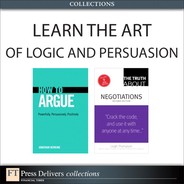Truth 2. The magic bullet: Preparation
Most people look for a magic bullet when it comes to negotiation, and, well, there is one. Are you ready? Okay, here it is: Prepare. After years of offering this advice, sending people off, and expecting magic to occur that never did, I finally realized the problem: Rehearsing does not equal preparation.
There are two styles of preparation, and only one of them works. Let’s call the two styles Pattern X and Pattern Y.
Pattern X Preparation
These activities seem to be useful but aren’t:
![]() Rehearsing your demands
Rehearsing your demands
![]() Pumping yourself up
Pumping yourself up
![]() Making a personal pledge to yourself or your partner to act tough
Making a personal pledge to yourself or your partner to act tough
![]() Figuring out how to derail the
Figuring out how to derail the
other negotiators or make them feel uncomfortable, which includes rearranging furniture, deliberately arriving late, and making them face glaring light
![]() Preparing backhanded compliments and outright insults
Preparing backhanded compliments and outright insults
![]() Rehearsing phrases such as “This is my final offer”; “My bottom line”; “This is a deal-breaker”; “Nonnegotiable”; and “Then we don’t have a deal”
Rehearsing phrases such as “This is my final offer”; “My bottom line”; “This is a deal-breaker”; “Nonnegotiable”; and “Then we don’t have a deal”
![]() Framing your opening offer as a demand
Framing your opening offer as a demand
Pattern Y Preparation
These activities are extraordinarily useful, but negotiators often don’t engage in them:
![]() Brainstorming all issues under consideration (for example, payment, terms and conditions, indemnities, volume, distribution)
Brainstorming all issues under consideration (for example, payment, terms and conditions, indemnities, volume, distribution)
![]() Arranging those issues in order of importance or priority to you (either by using a simple rank order or allocating 100 points among the issues to reflect what percentage of overall importance each represents)
Arranging those issues in order of importance or priority to you (either by using a simple rank order or allocating 100 points among the issues to reflect what percentage of overall importance each represents)
![]() For each issue, brainstorming all the alternatives (for example, payment terms might range from 0 percent to paid-in-full)
For each issue, brainstorming all the alternatives (for example, payment terms might range from 0 percent to paid-in-full)
![]() Brainstorming issues the other party might care about
Brainstorming issues the other party might care about
![]() Identifying your most desirable set of terms for each of the issues
Identifying your most desirable set of terms for each of the issues
![]() Identifying and prioritizing your alternative courses of action to negotiating with this person (for example, liquidating your product)
Identifying and prioritizing your alternative courses of action to negotiating with this person (for example, liquidating your product)
![]() Identifying the other party’s potential alternative courses of action
Identifying the other party’s potential alternative courses of action
![]() Preparing an opening offer
Preparing an opening offer
If negotiators did even a subset of these activities to prepare for a negotiation, they would fare dramatically better than if they didn’t. In other words, Pattern Y negotiators have measurably better outcomes than do Pattern X negotiators. Pattern X is more likely to strike out; Pattern Y gets you to yes.
Pattern Y negotiators have measurably better outcomes than do Pattern X negotiators.
The question, then, is how to get people to follow Pattern Y when most of them are used to Pattern X. Clearly, relying on natural instinct won’t work. So let me suggest that you use a strategy I call guided preparation. If unguided preparation is allowing negotiators to do whatever they want, guided preparation is giving them a step-by-step method to follow. Professor Jeanne Brett at the Kellogg School of Management devised an easy-to-follow model that you can use with a single sheet of paper divided into three columns:
1. List all the issues to be negotiated in the first column. (Be ready to add issues the other party mentions.)
2. For each of the issues listed, in the second column, indicate its relative importance to you (by rank ordering or allocating 100 points among the issues), your most desired terms, and your underlying interests.
3. For all issues, in the third column make your best guess about the counterparty’s interests, rankings, and most desired terms.
If you have accomplished these three things, you can get some sleep, knowing you have prepared effectively.
